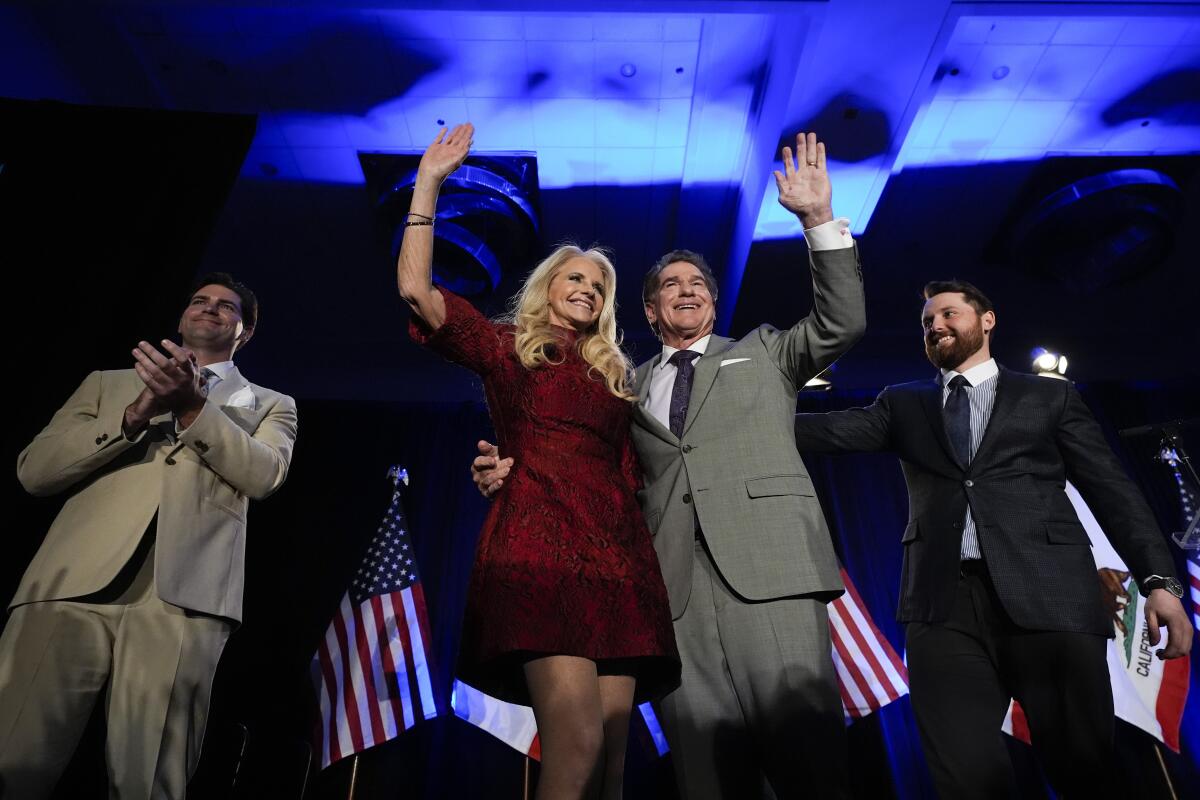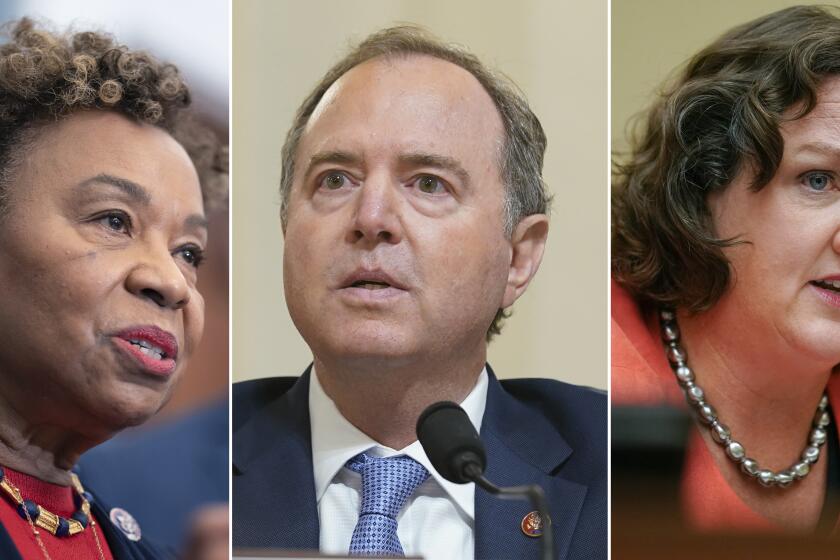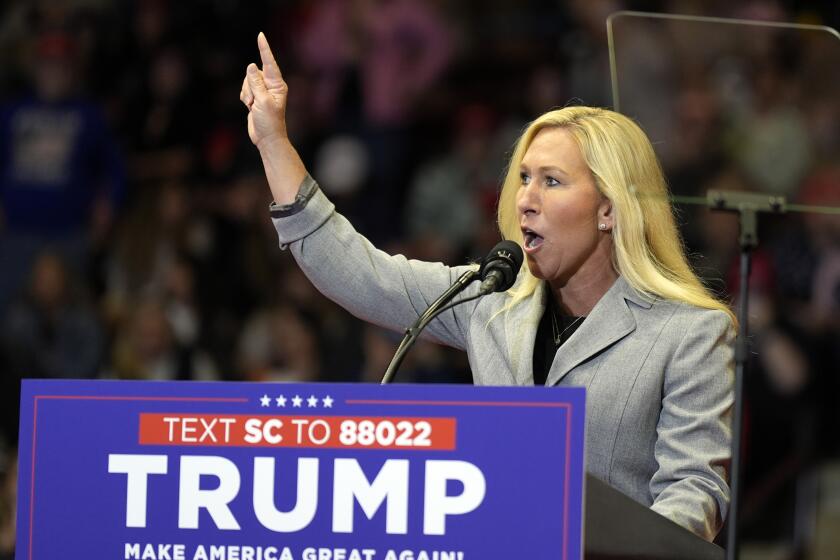Opinion: Steve Garvey’s strange win is a loss for California election reform. Here’s the solution

- Share via
The Dodgers don’t usually get any intentional help from their archrivals, the Giants. But something that strange just happened in California’s primary: Former Dodgers great and current Republican U.S. Senate candidate Steve Garvey advanced to the general election along with Democratic Rep. Adam B. Schiff — after being elevated almost entirely by the other team. The former National League MVP’s long-shot bid for the Senate benefited from an estimated $35 million in television ads from a surprising source: Schiff and his allies.
Why did the Burbank Democrat spend a small fortune boosting Garvey’s name recognition and blanketing the airwaves with ads that touted the former first baseman’s conservative credentials? You might call it a squeeze play: Schiff wanted to keep his two closest Democratic competitors out of the fall race, and he succeeded. Garvey claimed the second-highest vote total in the top-two primary, while Democratic Reps. Katie Porter of Irvine and Barbara Lee of Oakland finished in third and fourth, leaving them out of the running.
This is a classic example of a problem that could be solved by ranked-choice voting, a tested, nonpartisan reform that discourages this sort of gamesmanship and more accurately represents what a majority of voters want.
Adam Schiff, Katie Porter, Barbara Lee, Ro Khanna and other Democrats are in contention to succeed the senator. It’s another test for a rickety election reform.
Schiff’s skulduggery was unfortunate but totally rational under the current system. In California’s unusual “jungle” primary, every candidate runs in the same preliminary election, and the top two vote-getters move on to the general election regardless of party affiliation. Schiff seemed certain to claim one of the two spots from the beginning, but he faced a potentially competitive race in the fall against a progressive Democrat such as Porter or Lee.
So Schiff decided to try to choose an easier opponent. California Democrats outnumber Republicans 2 to 1, and the state’s voters haven’t sent a Republican to the Senate in 35 years.
Schiff’s beneficence deserves much of the credit for ensuring what has become an all too common feature of California’s general elections: a statewide contest in which a Democrat will probably trounce a sacrificial Republican instead of facing real competition from within his own party. Garvey’s largely quiet campaign did not air television ads of its own, and his campaign appearances were few and far between. The Republican spent just $1.4 million through mid-February, a small fraction of what Schiff and his allies spent boosting him.
Partisan primaries in mostly safe districts are pushing Congress and our national politics to the extremes. Abolishing them is a feasible and effective response.
Porter decried the contest as “rigged” because of Schiff’s tactics, but her allies got up to similar trickery. They tried to elevate a more conservative Republican, perennial candidate Eric Early, as “way more dangerous than Steve Garvey.” Their evident hope was to peel enough votes away from Garvey to allow Porter to finish second.
Our politics need not be this underhanded. It would be easy to end this chicanery and ensure that the candidates with the widest and deepest support face off in the fall.
Ranked-choice voting, whose renaissance started in the Bay Area and is quickly spreading across the country, is the best tool for reflecting the wishes of voters in any race with more than two candidates. It allows voters to rank their chosen candidates — first, second, third and so on — and enables an instant runoff: If no one secures a majority of first-choice votes, the last-place candidate is eliminated and their votes awarded to their supporters’ next choice, a process repeated until one candidate gets more than 50%. This eliminates spoiler candidates, wasted votes for eliminated candidates, winners with relatively small pluralities, and duplicitous tactics like Schiff’s and Porter’s.
One option is for California to adopt a “final four” model such as the one being used successfully in Alaska. Instead of advancing just two candidates from the primary, the state admits the top four to the general election, which is then decided by ranked choice.
This allows multiple candidates of different ideological stripes within a party to run against one another without splitting the field, which is particularly important in an overwhelmingly blue state like California. It also helps ensure that both major parties have at least one candidate in the general election. That could have allowed Schiff, Garvey, Lee and Porter to all make their cases before a much larger and more representative November electorate.
Voters, meanwhile, would be able to choose their actual favorite from a wide field — along with their second and subsequent choices — without any fear of playing spoiler. The winner would be the candidate with the deepest and broadest support among all California voters. And the election would have a completely different vibe: Instead of ignoring his strongest Democratic opponents, Schiff would have had to compete to be their supporters’ second choice.
California has long been at the vanguard of electoral reforms that produce fairer results, and the top-two primary was an important innovation. But there’s no reason to stop there.
Ranked-choice voting would make the state’s elections even fairer. The Dodgers don’t get to decide which teams they play, and politicians shouldn’t be able to get away with it either.
Marcela Miranda-Caballero is the executive director of the California Ranked Choice Voting Coalition. David Daley is a senior fellow at FairVote and the author of “Unrigged: How Americans Are Battling Back to Save Democracy.”
More to Read
A cure for the common opinion
Get thought-provoking perspectives with our weekly newsletter.
You may occasionally receive promotional content from the Los Angeles Times.












